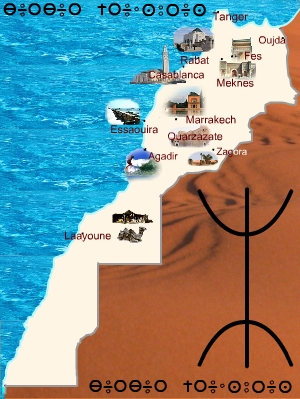Berber Treasures Morocco tours immerse you in exotic, unique and unforgettable Morocco exploring the fascinating history, landscape and culture of Morocco. We have prepared this summary of Morocco’s most evocative and sought after destinations – all magnificent – for first time Morocco travellers to help you choose the right itinerary for your ideal Morocco tour. And for return Morocco travellers and those interested in exploring or focusing on a particular interest or aspect of Moroccan culture, history or country-side, there are still more enthralling destinations, including many only a local expert with our extensive knowledge and experience knows (you won’t find them in guide books) – and we know them all.
All of these destinations and more can be included in the custom designed bespoke itinerary we will especially tailor make for your own individual personalised private tour of Morocco. Our small group Morocco tours include a full choice of destinations; if your favourite small group tour itinerary is missing a must-see for you, then talk to us about including it as a pre or post tour extension.
We are here to help you choose the Morocco tour itinerary perfect for you: contact us now.
Morocco’s Famous Cities, Towns & Villages
Experience the varied history, architecture and exotic charm of Morocco’s cities, towns and villages. The ancient imperial cities of Rabat, Fes, Marrakech, and Meknes, with their medinas and maze-like twisting streets, historical monuments and magical souks, contrast dramatically with the desert towns of Erfoud, Merzouga and Zagora and the coastal cities such as Essaouira and Tangier – each place striking in its own way.
Agadir
Agadir is a popular beach holiday destination and fishing port located on the southern Atlantic coast.
Ait Benhaddou
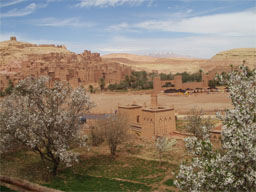 The stunning UNESCO world heritage village of Ait Benhaddou has some of the most exotic and best preserved Kasbahs. Located in southern Morocco close to Ouarzazate which is (the largest town in the region) Ait Benhaddou has been the setting for many films, including Lawrence of Arabia, The Mummy, and Gladiator. The old ksar (fortified village), situated on a hill across the Ouarzazate River from the new village, is largely uninhabited today and can be explored on foot.
The stunning UNESCO world heritage village of Ait Benhaddou has some of the most exotic and best preserved Kasbahs. Located in southern Morocco close to Ouarzazate which is (the largest town in the region) Ait Benhaddou has been the setting for many films, including Lawrence of Arabia, The Mummy, and Gladiator. The old ksar (fortified village), situated on a hill across the Ouarzazate River from the new village, is largely uninhabited today and can be explored on foot.
Azrou
Azrou is an old Berber market town in the north of Morocco close to Meknes and Fes. The town lies in a wide, flat valley dominated by the mountain slopes of the Middle Atlas Mountains. In the nearby cedar forests you can find mature cedar trees, the largest more than 30 meters tall.
Casablanca
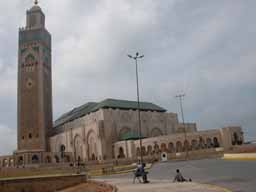 Casablanca is the largest, and probably best known, city in Morocco. Located on the Atlantic coast, Casablanca is the economic capital of Morocco.
Casablanca is the largest, and probably best known, city in Morocco. Located on the Atlantic coast, Casablanca is the economic capital of Morocco.
The centre of business and industry, Casablanca has the country’s principal port, and its largest international airport, Mohammed V International Airport. The old and the new coexist from the original, walled medina to the modern Hassan II Mosque, one of the largest mosques in the world.
Chefchaouen (the “Blue Town”)
Located in the Rif Mountains mid-way between Tangier and Fes, the small mountain town of Chefchaouen dates back from the 15th century. Situated on the steep mountain side below two mountain peaks of the Rif, the pretty old historic section of Chefchaouen, still largely encircled by its 16th century battlements, maintains a medieval feel. Here in the old town medina the pretty blue-washed buildings of the medina have led to its popular alias as Morocco’s “blue town”.
Erfoud
Established during the French colonial period, the small town of Erfoud is the last town before reaching the spectacular Erg Chebbi sand dunes of the Sahara Desert and Morocco’s desert oasis villages of Merzouga and Rissani.
Essaouira
Inhabited since prehistoric times, today Essaouira is a relaxed, Atlantic coast town. A few hours from Marrakech, its location, temperate climate and blend of Portuguese and Moroccan history and architecture make it a favourite beachside destination, but there is far more to Essaouira than its lovely beach. The town ramparts, white and blue washed buildings are reminders of the town’s history as a Portuguese trading port. The 18th century medina is a UNESCO listed world heritage site. The town is also host to renown annual Andalusian and Gnawa music festivals.
Fes (Fez)
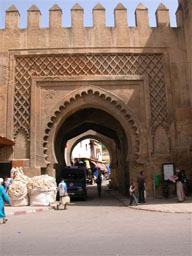 Originally founded in the 9th century, Fes was Morocco’s capital for over 400 years and is one of the country’s oldest imperial cities. The city is one of the world’s largest remaining medieval cities and is famous for its history, architecture, cuisine and souks.
Originally founded in the 9th century, Fes was Morocco’s capital for over 400 years and is one of the country’s oldest imperial cities. The city is one of the world’s largest remaining medieval cities and is famous for its history, architecture, cuisine and souks.
The UNESCO world heritage old walled medina encompasses remarkable historical monuments such as the 14th century Bou Inania Madrasa (medersa), Al Attarine Madrasa, Fes el Jdid Madrasa and the 9th century Kairaouine (Karaouyine) Mosque, as well as its many bazaars and souks (such as the Souk Ain Allou (leather), the Souk Attarine (spices), Souk au Henne (henna and kohl), the exterior of Dar el Makhzen (Royal Palace) including the enormous Marinid gate of Bab Dekakene, formerly the main entrance of the royal palace. Orient yourself with the panoramic view of Fes from the late 16th century Borj Nord fortress which overlooks the city.
Marrakech (Marrakesh)
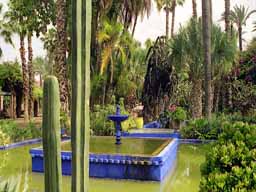 The very name Marrakech is evocative of all that is exotic and rich about Morocco. Famous among tourist for its souks (markets) and Djemaa el Fna Square (a bustling market square by day which gives way to a multitude of open air cafes at night), Marrakech is an old imperial town and UNESCO world heritage site. The red walled medina’s many historical sights, the La Bahia Palace, el Badi Palace, the Saadian Tombs and Koutoubia Mosque offer a fascinating insight into the city’s past and present. The city’s beautiful gardens, such as Majorelle Garden and Secret Garden, offer a peaceful respite from the busy city centre.
The very name Marrakech is evocative of all that is exotic and rich about Morocco. Famous among tourist for its souks (markets) and Djemaa el Fna Square (a bustling market square by day which gives way to a multitude of open air cafes at night), Marrakech is an old imperial town and UNESCO world heritage site. The red walled medina’s many historical sights, the La Bahia Palace, el Badi Palace, the Saadian Tombs and Koutoubia Mosque offer a fascinating insight into the city’s past and present. The city’s beautiful gardens, such as Majorelle Garden and Secret Garden, offer a peaceful respite from the busy city centre.
Meknes
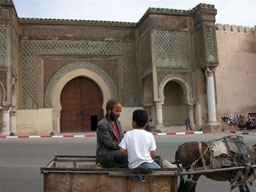 The history of the ancient imperial city of Meknes extends back as far as the 8th century when it is believed the area was first settled. Meknes, a UNESCO owrld heritage site, is referred to as the Versailles of Morocco. The old city’s famous massive gate of Bab el Mansour, is the main entrance to the second Alaouite sultan, Moulay Ismails’s, 17th century imperial city.
The history of the ancient imperial city of Meknes extends back as far as the 8th century when it is believed the area was first settled. Meknes, a UNESCO owrld heritage site, is referred to as the Versailles of Morocco. The old city’s famous massive gate of Bab el Mansour, is the main entrance to the second Alaouite sultan, Moulay Ismails’s, 17th century imperial city.
Merzouga
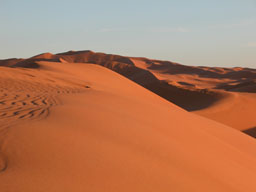 The culturally fascinating desert oasis village of Merzouga is situated on the edge of the spectacular Erg Chebbi Sahara Desert sand dunes, the highest, most photogenic sand dunes of Morocco’s desert. Home of the Berber nomad Blue Men, the Merzouga area is the premier staging point for desert camp stays and the perfect location for desert camel rides into the desert dunes and oases areas.
The culturally fascinating desert oasis village of Merzouga is situated on the edge of the spectacular Erg Chebbi Sahara Desert sand dunes, the highest, most photogenic sand dunes of Morocco’s desert. Home of the Berber nomad Blue Men, the Merzouga area is the premier staging point for desert camp stays and the perfect location for desert camel rides into the desert dunes and oases areas.
Midelt
The market town of Midelt lies between the Middle and High Atlas Mountains on the road from Fes in the north to Errachidia and Erfoud in the south.
Ouarzazate
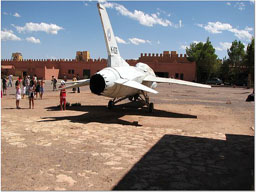 Strategically located on the cross-roads of an old caravan trading route and craddled between the High Atlas Mountains and Anti-Atlas Mountains, the oasis town of Ouarzazate spills out along side the Ouarzazate oasis. Known as the Gateway to the Desert, the Berber town of Ouarzazate became a garrison town for the French Foreign Legion during the French colonial period. Parts of the old Legion garrison still survive today. The historic Glaoui Taourirt Kasbah and Atlas Studios (one of the largest film studios in the world) are located here. The stunning visual contrast of the soaring mountains and desert has made Ouarzazate the movie making capital of Morocco. Films and major television production such as Kingdom of Heaven, Gladiator, Star Wars, Kundun, Alexander, Lawrence of Arabia and Game of Thrones were made in this area. Ouarzazate also serves as a convenient central base for those who prefer to explore the desert region of the South (Skoura, Tineghir (Tinerhir), Todra Gorge, Dades Gorge, Fint, Zagora, the Roses Valley and Road of a Thousand Kasbahs) by day trips.
Strategically located on the cross-roads of an old caravan trading route and craddled between the High Atlas Mountains and Anti-Atlas Mountains, the oasis town of Ouarzazate spills out along side the Ouarzazate oasis. Known as the Gateway to the Desert, the Berber town of Ouarzazate became a garrison town for the French Foreign Legion during the French colonial period. Parts of the old Legion garrison still survive today. The historic Glaoui Taourirt Kasbah and Atlas Studios (one of the largest film studios in the world) are located here. The stunning visual contrast of the soaring mountains and desert has made Ouarzazate the movie making capital of Morocco. Films and major television production such as Kingdom of Heaven, Gladiator, Star Wars, Kundun, Alexander, Lawrence of Arabia and Game of Thrones were made in this area. Ouarzazate also serves as a convenient central base for those who prefer to explore the desert region of the South (Skoura, Tineghir (Tinerhir), Todra Gorge, Dades Gorge, Fint, Zagora, the Roses Valley and Road of a Thousand Kasbahs) by day trips.
Rabat
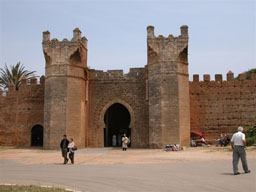 Rabat is the capital of the kingdom and the modern administrative centre of Morocco. One of the four imperial cities, and a UNESCO world heritage site, Rabat’s notable sights include the historic Oudaya Kasbah, the Hassan Tower, the Mohammed V Mausoleum, the Royal Palace (Mechouar) and the Necropolis of Chellah, situated in the ruins of the ancient Roman town of Sala Collonia.
Rabat is the capital of the kingdom and the modern administrative centre of Morocco. One of the four imperial cities, and a UNESCO world heritage site, Rabat’s notable sights include the historic Oudaya Kasbah, the Hassan Tower, the Mohammed V Mausoleum, the Royal Palace (Mechouar) and the Necropolis of Chellah, situated in the ruins of the ancient Roman town of Sala Collonia.
Tangier (Tanger)
Tangier is an important industrial coastal port city located at the northern tip of Morocco at the entrance to the Gibraltar Straights where the Atlantic Ocean and Mediterranean Sea meet. First established as a trading settlement by the Phoenicians, Tangier is one of the oldest cities in Morocco. Today the city is connected by ferries to Gibraltar and Spain.
Taroudant
The southern town of Taroudant is situated in the Sous Valley to the west of the Anti-Atlas Mountains, An old caravan town, Taroudant’s medina is surrounded by a striking 7.5 km long wall.
Volubilis
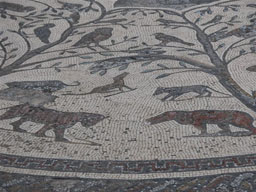 A short distance to the north-west of Fes, the Roman ruins of Volubilis offer a glimpse into the Roman past of Morocco. Located on a hillside overlooking a fertile valley, the ruins of this UNESCO world heritage ancient Roman town contain some marvellous mosaics. The remains of many significant buildings can be explored including the Basilica, Thermae, Temple of Jupiter, Capitol, and Triumphal Arch.
A short distance to the north-west of Fes, the Roman ruins of Volubilis offer a glimpse into the Roman past of Morocco. Located on a hillside overlooking a fertile valley, the ruins of this UNESCO world heritage ancient Roman town contain some marvellous mosaics. The remains of many significant buildings can be explored including the Basilica, Thermae, Temple of Jupiter, Capitol, and Triumphal Arch.
Zagora
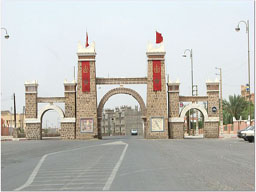 The old Berber oasis camel caravan town of Zagora is located in the south-east of Morocco in the Draa Valley. Situated among the date palm groves and oasis of the Draa Valley, Zagora was a stopping point on the ancient desert camel caravan route. Famously, Zagora claims, as indicated by a sign posted in the town, it is 52 days (by camel) from Timbuktu, Mali.
The old Berber oasis camel caravan town of Zagora is located in the south-east of Morocco in the Draa Valley. Situated among the date palm groves and oasis of the Draa Valley, Zagora was a stopping point on the ancient desert camel caravan route. Famously, Zagora claims, as indicated by a sign posted in the town, it is 52 days (by camel) from Timbuktu, Mali.
Morocco’s Natural Heritage: The Mountains, Valleys, Gorges & More
Atlas Mountains
Anti Atlas Mountains:
The Anti-Atlas Mountains lay in southern Morocco. The unique mountain range extends in a north-easterly direction from the Atlantic coast south of Tiznit towards Ouarzazate and are bounded on their eastern side by the Draa River. The higher mountain peaks are around 2,500 to 2,700 meters.
High Atlas Mountains:
The High Atlas Mountain range is situated in central Morocco. The mountain range begins on the Atlantic coast near Agadir, extends in a north-easterly direction between Marrakech and Ouarzazate, continuing past Midelt toward Algeria. The highest of the mountain peaks exceed 4000 meters. The road from Marrakech to Ouarzazate and the Sahara Desert travels through the Tizi n’Tichka pass at 2260 meters.
Middle Atlas Mountians:
The Middle Atlas Mountains lay in the north of Morocco. Morocco’s Middle Atlas Mountains lay in a north-easterly direction from near Beni Mellal, passing to the east of Meknes and Fes, towards Guercif. The Middle Atlas Mountains have extensive cedar forests, home to the Barbary macaque. The cedar forests are said to be the largest southern Mediterranean forest and a remnant of a forest ecosystem that once extended through all Northern Africa, Spain, Turkey and Lebanon. (Ciani and Castillo, University of Padova, Italy).
Dades Gorge
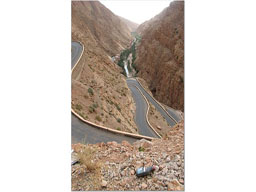 The landscape of the Dades Gorge is unique and hauntingly beauty. Incredible and surreal red rock formations line either side of the steep Gorge which is divided by the Dades River.
The landscape of the Dades Gorge is unique and hauntingly beauty. Incredible and surreal red rock formations line either side of the steep Gorge which is divided by the Dades River.
The Gorge is near the town of Boumalne Dades in central south Morocco. The road to Dades Gorge from Boumalne Dades passes by Berber ksars (fortified villages), almond and fig groves, enters the base of the Gorge and then snakes up the steep mountain side through a series of tight S-bends. You will be rewarded with stunning views of the Gorge from the viewing area along the top of the Gorge as well as from the road on the way up.
Draa Valley
The D’raa Valley carved by the ancient Draa River, the longest river in Morocco, is renowned for its many Kasbahs, oases and the dates, figs and henna that grow there. The beautiful date palm groves of the Draa Valley are like a green sea in the middle of the desert. During August and September, the thousands of date palms are laden with dates and the air heavy with the fragrant scent of henna flowers.
Rif Mountains (Riff)
The Rif Mountain range is Morocco’s northerly most mountain range. The rugged mountain range is roughly bounded by the Middle Atlas and Moulouya River in the east, Morocco’s Mediterranean Coast line in the north, Tangier in the west and Fes in the south. Pretty Chefchaouen, Morocco’s blue town, is located in the Rif Mountains.
Todra Gorge
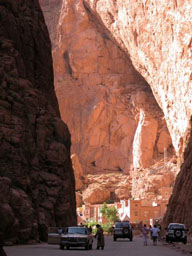 Todra Gorge is carved out of the mountains of the High Atlas. The reddish orange stone face of the 300m high cliffs of the Gorge seems to glow in the early morning and late evening sunlight. The road from Tineghir (Tingerhir) follows the clear Todra River waters which cut through the Gorge. A paved road extends a few hundred meters through the base of the narrowest section of Todra Gorge; at its narrowest point the Gorge is only 10 meters wide. It is an easy walk though this base section of Todra Gorge. The road continues along the Todra River disappearing off into the further reaches of this magnificent Eastern section of the High Atlas Mountains.
Todra Gorge is carved out of the mountains of the High Atlas. The reddish orange stone face of the 300m high cliffs of the Gorge seems to glow in the early morning and late evening sunlight. The road from Tineghir (Tingerhir) follows the clear Todra River waters which cut through the Gorge. A paved road extends a few hundred meters through the base of the narrowest section of Todra Gorge; at its narrowest point the Gorge is only 10 meters wide. It is an easy walk though this base section of Todra Gorge. The road continues along the Todra River disappearing off into the further reaches of this magnificent Eastern section of the High Atlas Mountains.
Ziz Valley
Located on the Fes – Errachidia road, the Ziz Valley runs south from the town of Rich through Erfoud to the desert oasis village of Merzouga on the fringe of the soaring Sahara Desert Erg Chebbi sand dunes. The Valley with its extensive palm groves and oases was once a route for the desert caravans travelling to the north and the Mediterranean.

